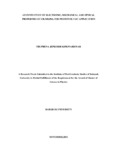AB INITIO STUDY OF ELECTRONIC, MECHANICAL AND OPTICAL PROPERTIES OF CH 3 NH 3 PbI 3 FOR PHOTOVOLTAIC APPLICATION
Abstract
The ever increasing need of energy in third world countries has necessitated the need for
coming up with measures of seeking alternative energy sources. Solar energy is one of
the most important alternative sources of energy because of its abundance in these
regions. Up to this time, the use of the first and second generations solar cells made of
silicon in making solar panels has notable shortcomings such as unaffordability and lack
of longevity of the electric power generated. In this regard, therefore, this study purposes
to establish ideal photovoltaic properties which increases the durability and efficiency of
CH3 NH3 PbI3 solar cells. The purpose of this work was to study computationally the
electronic, mechanical and optical properties of CH vii 3 NH3 PbI3 and its potential application
in photovoltaic. The specific objectives include determining electronic, mechanical and
optical properties of CH3 NH3 PbI3 from first principles and to establish the ideal
properties of CH3 NH3 PbI3 for photovoltaic applications. Electronic, mechanical and
optical properties of CH3 N3 PbI3 were calculated using ab initio methods specifically
Quantum Espresso code. The norm conserving pseudo potential was used. Band gap was
calculated as 1.58 eV which is close to the experimental value which is approximately
1.56 eV. Elastic constant parameters such as bulk modulus B, Young’s modulus E, shear
modulus G and Poisson’s ratio ν were calculated using the Voigt–Reuss–Hill averaging
scheme. Our calculated lattice parameter a is 6.39 Å comparable to experimental value
of 6.33 Å while the Poisson’s ratio () in this work is 0.25 and experimental value is
0.28.Optical properties like real 𝜀1 and imaginary part (𝜀 2) of dependent dielectric
function and absorption coefficient were calculated and discussed. The calculated values
of all parameters were compared with the available experimental and theoretical values.
There is a fairly good agreement between experimental data and this computational
work. These findings establish systematic design rules to achieve silicon like efficiencies
in a basic CH3 NH3 PbI3 perovskite solar cell.

